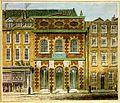John Vanbrugh facts for kids
Quick facts for kids
Sir John Vanbrugh
|
|
|---|---|
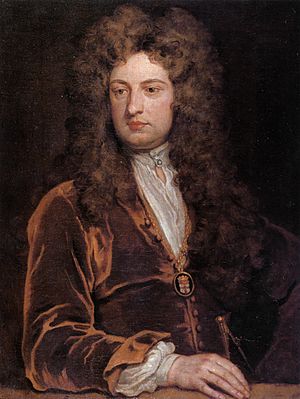
A portrait of John Vanbrugh by Godfrey Kneller, found in the National Portrait Gallery.
|
|
| Born | 24 January 1664 |
| Died | 26 March 1726 (aged 62) |
| Occupation | Architect |
| Buildings | Blenheim Palace Castle Howard Seaton Delaval Hall Grimsthorpe Castle Stowe House Kings Weston House |
Sir John Vanbrugh (born January 24, 1664, died March 26, 1726) was a famous English architect and writer. He is most known for designing grand buildings like Blenheim Palace and Castle Howard. He was made a knight in 1714.
Early Life and Adventures
John Vanbrugh was born in London, England, and was one of 19 children! His family moved to Chester when he was young. This was because of the Great Plague in 1665 or the Great Fire in 1666.
For a few years, people weren't sure what Vanbrugh did after school. It was later discovered that he worked for the East India Company. He was at their trading post in Surat, India, where his uncle was a governor.
Time in Prison and New Ideas

From 1686, Vanbrugh worked secretly to help bring William of Orange to power. This led to the Glorious Revolution in 1688. He was arrested in France in 1688, accused of being a spy.
Vanbrugh stayed in French prisons for four and a half years. He was moved to the Bastille prison in 1692. He was finally released in November of that year. After his release, he spent three months in Paris. During this time, he saw many amazing French buildings. These buildings were much grander than anything in England. This experience likely influenced his future architectural ideas.
He returned to England in 1693. He then joined the Navy for a short time. Later, he decided to focus on writing plays and designing buildings.
A Career in Plays and Palaces
Vanbrugh had a varied career in London. He wrote two popular plays, The Relapse (1696) and The Provoked Wife (1697). These plays were very popular but also caused some debate.
Even though he had no formal training, Vanbrugh became a skilled architect. He spent almost 30 years designing and working on many buildings. Often, he would rebuild or update existing houses. This meant he had to follow the owner's wishes. So, some houses that say Vanbrugh designed them might not fully show his own ideas.
In 1699, Vanbrugh traveled around northern England. He visited many large Elizabethan houses. These included places like Burghley House and Hardwick Hall. He studied their towers, unique roofs, and windows. These features later appeared in his own designs.
Vanbrugh was also interested in improving London's streets. In 1723, it was reported that he suggested a tax on coaches. This money would be used to pave streets and build underground drains.
Vanbrugh loved the Baroque style. This grand style was popular across Europe. The first Baroque country house in England was Chatsworth House. Vanbrugh managed to get the job to design Castle Howard. He won over the professional architect William Talman. Vanbrugh then helped change European Baroque into a unique English style.
Here are four of his most important designs:
- Castle Howard, started in 1699.
- Blenheim Palace, started in 1704.
- Kings Weston House, started in 1712.
- Seaton Delaval Hall, started in 1718.
He worked on these projects one after another. This helped his ideas and style grow over time.
Family Life
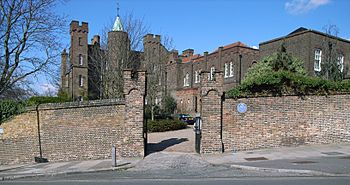
In 1719, Vanbrugh married Henrietta Maria Yarburgh. She was 26, and he was 55. Despite the age difference, they had a very happy marriage. They had two sons together. Unlike the characters in his plays, Vanbrugh's personal life was calm and without scandal.
Later Years and Legacy
Vanbrugh died on March 26, 1726, from asthma. He passed away in a small house he designed in 1703. He spent most of his married life in Greenwich. He lived in a house called Vanbrugh Castle. This castle was a small Scottish-style tower house. It was one of his earliest designs. Today, it is a protected building and has been divided into apartments.
Vanbrugh was buried in a church in London, but his grave is not marked.
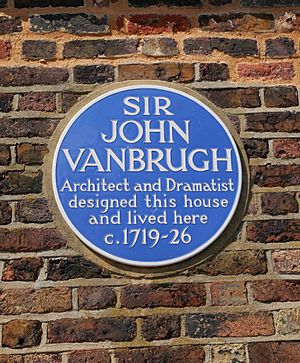
Vanbrugh is remembered for his huge impact on British culture. This includes his work in theatre and, especially, architecture.
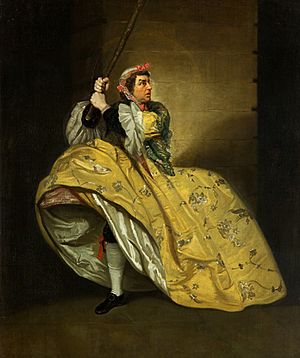
After Castle Howard was finished, English Baroque architecture became very popular. Vanbrugh thought about buildings in a new way. He focused on their size, shape, and how they looked from different angles.
His friend and helper, Nicholas Hawksmoor, continued to design churches in London. Vanbrugh's cousin and student, Edward Lovett Pearce, became a great architect in Ireland. Vanbrugh's influence can also be seen in buildings in Yorkshire.
Today, Vanbrugh is honored across Britain. Many inns, streets, and even a college at the University of York are named after him.
Images for kids
-
Vanbrugh's south side of Castle Howard.
-
The west side of Blenheim Palace shows its unique, tall stone towers.
-
Vanbrugh's grand East Gate at Blenheim Palace looks more like the entrance to a fortress than a palace.
-
The top part of the south entrance is very unusual. It has a flat top decorated with a marble bust of Louis XIV. This bust was taken from Tournai in 1709.
-
Blenheim Palace's great court and main entrance.
See also
 In Spanish: John Vanbrugh para niños
In Spanish: John Vanbrugh para niños


